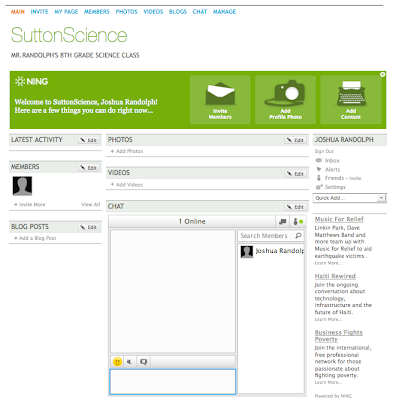The Closer Radio Drama
Thursday, April 22, 2010
Monday, April 19, 2010
BP11_2010043_Web2.0_Tool3
It's a Ning Thing
With the explosion of social media popularity among kids and adults today, it makes sense to harness this love affair for educational purposes. It doesn’t take long, when teaching 8th graders, to realize that social connections are of prime importance. If these connections can be welcomed into the classroom vs. expelled, educators may find success among students who otherwise show little interest. This would be a huge win for all involved. Teachers love nothing better than to have students engaged in what is being taught. Not only this, but an engaged student is much more likely to actually learn something in the classroom and - maybe, just maybe - gain an interest that will help motivate them in the years ahead.
“How might this look in the classroom?” you ask. Great question! One way educators are tapping the social media well is through a Web2.0 application called “Ning”. Similar in many ways to Facebook, the Ning social media platform allows users to become members in order to participate in the member dialogue. This digital dialogue takes shape in many ways. Once a group has been set up, members can chat, blog, comment on posts, create discussions, send messages, share photos, and even videos. Privacy settings can also be initiated in order to keep group interaction limited to a targeted audience. Also, there are no charges involved in order to become a member or create a group. With these features, and even more that I didn’t mention, Ning is proving to be a very useful tool on the 21st century educator’s laptop.
BP10_2010043_Link to Comment on Another's Blog
Post to Bill Carrigan's Blog:
Bill, this quick 1 minute fly-by of photoshop express was extremely helpful. The screen flow moved at a great pace in sync with the commentary. This looks like a great option for students in public schools who may not have access to high-powered and high-dollar photo editing applications. Thanks for the great post!
http://billyc3.blogspot.com/2010/04/bp82010042one-minute-movie-photoshop.html
Bill, this quick 1 minute fly-by of photoshop express was extremely helpful. The screen flow moved at a great pace in sync with the commentary. This looks like a great option for students in public schools who may not have access to high-powered and high-dollar photo editing applications. Thanks for the great post!
http://billyc3.blogspot.com/2010/04/bp82010042one-minute-movie-photoshop.html
BP9_2010043_Link to Comment on Another's Blog
Post to Paul Devoto's Blog:
Paul, as I sipped some coffee and enjoyed your 1 minute video on Wikis I couldn't help but smile. Your witty script and great casting teamed up with your production skill to create a great sell for the wiki. Great job and thanks for the smile.
http://pauldevoto.blogspot.com/2010/04/bp82010041oneminutemessage1_18.html
Paul, as I sipped some coffee and enjoyed your 1 minute video on Wikis I couldn't help but smile. Your witty script and great casting teamed up with your production skill to create a great sell for the wiki. Great job and thanks for the smile.
http://pauldevoto.blogspot.com/2010/04/bp82010041oneminutemessage1_18.html
Saturday, April 17, 2010
Tuesday, April 13, 2010
BP7_2010042_Link to Comment on Another's Blog

(Image taken from Bill Carrigan's blog at http://billyc3.blogspot.com/2010/04/bp42010041web-20-tools.html)
Bill,
Thanks for the heads up on the Aviary Phoenix application. I love the fact that you don't have to install any software in order to run the application. (and the fact that it's free!) Many of the computers in my school run from a server and require software to be installed on the main server in order to be available on each individual station. The copyrights, costs, and manpower to make it happen make this very prohibitive for new software that a teacher may want to add. It sounds like Aviary has come up with a solution for a problem just like ours.
Thanks for the post!
(In response to the post found at http://billyc3.blogspot.com/2010/04/bp42010041web-20-tools.html)
BP6_2010042_Link to Comment on Another's Blog

(picture taken from the dy/dan blog found at http://blog.mrmeyer.com)
Paul,
I appreciate the RSS feeds you posted to some really great thinkers. I read Godin's "the dip" a few years back and found it insightful. I subscribed to his RSS feed and look forward to catching his flashes of insight more often. I also read a few entries from dy/dan and was convinced to subscribe. In my short reading he really challenged me in the area of how I am questioning in my classroom. Great post!
(Posted in response to http://pauldevoto.blogspot.com/2010/04/bp42010041rssfeeds.html)
BP5_2010042_Web2.0Tool2

Mind Mapping with bubbl.us
Mind mapping, or concept mapping as it is sometimes referred to, is a powerful tool in the educator’s toolbox. I love the way it allows the learner to apply what they know about a specific concept and then arrange it in the larger context of a given theme. Each placement requires prior knowledge to be accessed and then real-time decisions to be made concerning how it might fit the given map. Not only does mind mapping reveal an understanding, or lack thereof, of concepts at hand, but for me it seems to tap into the multiple intelligences that Howard put forth in his book Intelligence Reframed. (Howard, 1999) The linguistic intelligence would be a shoe in for this type of project, but perhaps not the only one. For me, arranging objects in a certain pattern in a given space brings into play the spatial intelligence as well. Speaking of the spatial intelligence, Howard (1999) said it provides, “the potential to recognize and manipulate the patterns of wide space as well as the patterns of more confined areas” (p.42). It is this connection between the intelligences that, I believe, helps make mind mapping such a great tool. Another great aspect of this educational tool is its accessibility. Only a chalk or white board is needed to bring the map to life.
That was then and this is now. With today’s generation of digital natives it is almost necessary to translate the tool into the digital realm in order to avoid extinction. In order to take this idea to the digital platform one would need to make sure that a few elements were not lost in the translation. That’s where http://bubbl.us comes into play. This excellent Web2.0 tool makes mind mapping a breeze to use by keeping the interface simple and the output gorgeous. The next time you need a mind map or you want your students to create one be sure to check it out!
References
Howard, G. (1999). Intelligence reframed. New York: Basic Books.
Thursday, April 1, 2010
BP4_2010041_RSS Feeds

The video short on RSS feeds was excellent. Here are the five RSS feeds I am currently subscribing to:
Gigaom
“Trusted Insights and Conversations on the Next Wave of Technology”
This helps keep me abreast on technology related developments. There was an article this week I was able to use in class as it connected the 700Mhz range of the EM spectrum to potential profits by the US government.
Apple Blog
“News, reviews, walkthroughs, and real-life application of Apple products”
I always appreciate tips to help make my technology as efficient and productive as possible.
Web 2.0 in the Classroom
“Welcome to my blog where I explore everything Web 2.0 in the classroom”
I’ll let her do the exploring and pass on the nuggets to me!
Adobe Education Technologies
“Information, insight, and tips from Adobe’s technology team dedicated to education”
Getting into the Adobe Master Collection requires a pretty steep learning curve. This blog may help span the divide with some useful tips from time to time.
Science in School
“Highlighting the best in science teaching and research”
This journal for science teachers is produced in Europe and has some really great hands-on ideas for the classroom.
BP3_2010041_Web 2.0 T1 - Wonder Wheel
Google Wonder Wheel
If you enjoy a good diagram over bullet points, then internet searching is about to get a whole lot more productive and fun. "Wonder Wheel" is a new search tool that Google has brought out of the lab stage and onto the main scene. (OK, maybe not the main scene but still pretty easy to find.) Let me demonstrate:
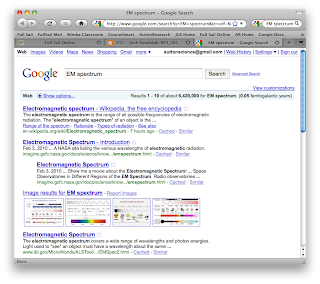
Here I Googled the phrase "EM spectrum" in the traditional manner. Lists of sites and also some images appear in the results. Now lets use the Wonder Wheel. First click "show options" under the search input pane. The screen will have options listed down the left side of the page as seen below:
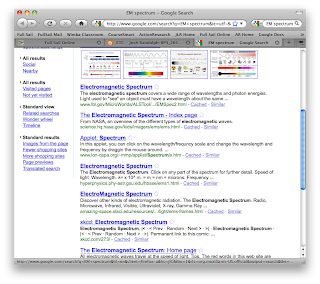
Now scroll down until you see the "Wonder Wheel" option and click on it. You will then see your search organized as if it were a concept map! Check out the screen shot below:
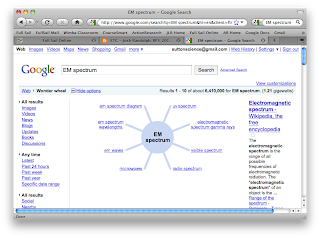
The center of the wheel is the main search phrase, and links to this center are listed on the right side of the page. The spokes of the wheel have related concepts and may help you narrow down your search before landing on a website link. If I click on the spoke titled "microwaves" another wheel is added to the page and the concept map is extended:
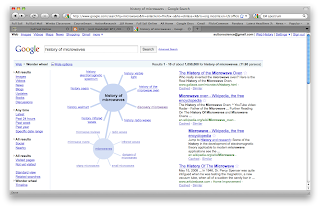
I went ahead and clicked on a spoke titled the "History of microwaves" and it became the center of a new wheel. I am now able to see an updated list of search results on the right side of the page that relate to this wheel. I found a NASA site that looked like a good option and clicked on it:
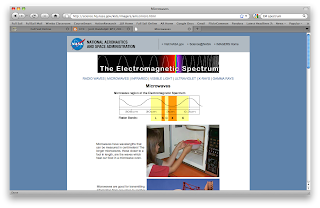
Hope you and your students find this Web 2.0 tool useful in your searching!
-josh
(I discovered this tool through the "Making Teachers Nerdy" blog. You can see her original blog at http://mrssmoke.onsugar.com)
If you enjoy a good diagram over bullet points, then internet searching is about to get a whole lot more productive and fun. "Wonder Wheel" is a new search tool that Google has brought out of the lab stage and onto the main scene. (OK, maybe not the main scene but still pretty easy to find.) Let me demonstrate:


Here I Googled the phrase "EM spectrum" in the traditional manner. Lists of sites and also some images appear in the results. Now lets use the Wonder Wheel. First click "show options" under the search input pane. The screen will have options listed down the left side of the page as seen below:

Now scroll down until you see the "Wonder Wheel" option and click on it. You will then see your search organized as if it were a concept map! Check out the screen shot below:

The center of the wheel is the main search phrase, and links to this center are listed on the right side of the page. The spokes of the wheel have related concepts and may help you narrow down your search before landing on a website link. If I click on the spoke titled "microwaves" another wheel is added to the page and the concept map is extended:

I went ahead and clicked on a spoke titled the "History of microwaves" and it became the center of a new wheel. I am now able to see an updated list of search results on the right side of the page that relate to this wheel. I found a NASA site that looked like a good option and clicked on it:

Hope you and your students find this Web 2.0 tool useful in your searching!
-josh
(I discovered this tool through the "Making Teachers Nerdy" blog. You can see her original blog at http://mrssmoke.onsugar.com)
Subscribe to:
Comments (Atom)
